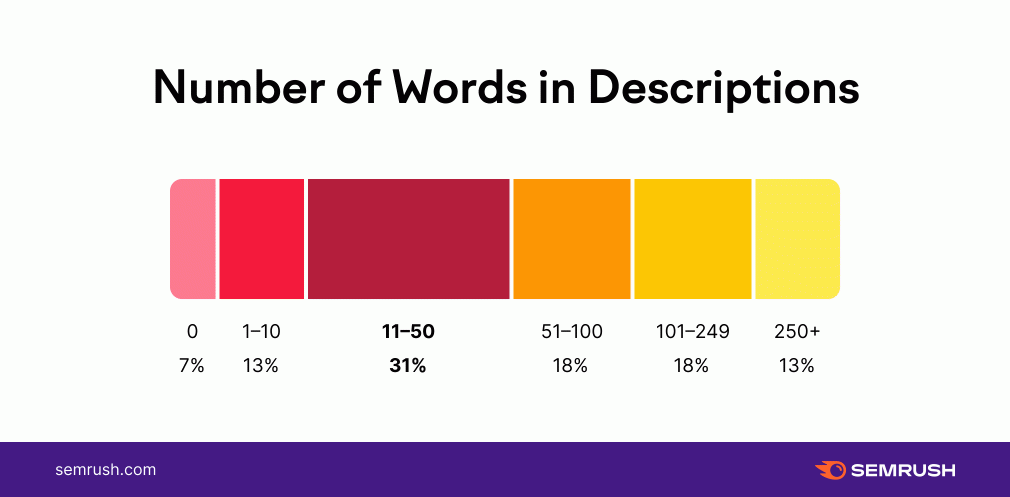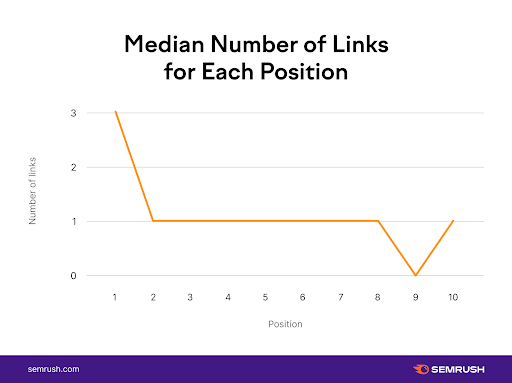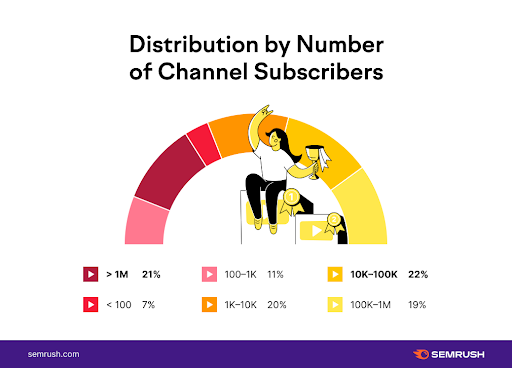Videos are all about sights and sounds. But you should pay special attention to the text to get your videos ranking higher in YouTube search rankings, the second largest search engine in the world.
It’s your title, description, tags, and keywords that matter. Yep, all those standard SEO elements.
Video may be all about sights and sounds, but you better pay attention to the text if you want to rank in @YouTube search. #CreatorEconomy #ContentEntrepreneur Share on XSemrush recently released a study identifying the differentiators among the top YouTube ranking results Here’s how they did it: They pulled 15K keywords from its Google keywords database, which triggered a featured video result on the search engine results page. Then, they took each keyword and analyzed the top 10 results for them on YouTube.
Titles
On average, most titles used eight words, with 54% using between six and 10 words. Interestingly, 24% contained only one to five words. Generally, wordy titles are not a popular tactic. Titles also should incorporate keyword(s) that match the content.

Descriptions
Use more words here so potential viewers can better understand what they will learn or see in the video. Include keywords the searcher may have used. The research found the average word count was 107. Among the descriptions for the top 10 YouTube search ranking analyzed, 31% use between 11 and 50 words, with 18% writing 51 to 100 words and another 18% crafting descriptions between 101 and 240 words.

Interestingly, 17% of the No. 1 rankings used at least 250 words in the description. Incorporating keywords is easier and important to the description. Over one-third (36%) of the top-ranking videos include them.
17% of No. 1 positions in YouTube search results have descriptions with at least 250 words, according to @Semrush 2021 research. #SEO #Video #ContentEntrepreneur Share on XWhen Semrush looked only at videos for “how-to” keywords, it found 52% used more than 100 words in the description, but only 31% of the general sample did.
Don’t forget to add links in your description. The top YouTube search ranking included three links in the description, while No. 2 through 10 included only one or no links. Semrush also found branded links (e.g., TheTilt.com/xx instead of shortened links (e.g., bit.ly/xx) could increase click-through rates by 39%.

Using hashtags in the description isn’t that important. YouTube only allows three per description.
Tags
The top-ranking videos used an average of 13 tags. Videos with fewer tags usually were found in the lower rankings. (Unlike hashtags, these tags serve more as indicators to the search engine. They appear below the video and should encompass the keywords the video is targeting.)
Top-ranking videos on @YouTube search average 13 tags via @Semrush research. The lesson? Use at least a dozen keywords as tags to increase your video's chance of getting found by searchers. Share on XSubscribers
Your following doesn’t have to be HUGE to earn ranking results. In fact, 42% of the best-ranking videos appeared on channels with between 1K and 100K subscribers.

Duration, watch time, and views
Almost half (45%) of the top-ranking videos ran between three and five minutes. On the opposite end, videos less than 60 seconds made up only 5% of the rankings.
In the Semrush analysis, the average number of views for a No. 2 video is 74% less than that for a No. 1 video.
What’s more critical, though, is the watch time. Videos viewed until their conclusion are more likely to rank higher.
Caveat: Don’t immediately conclude you need to create short videos so they’ll rank. Tailor your video to your topic. For example, viewers seeking to learn how to cook a turkey would want to watch a longer video if it went step by step, while someone wanting a quick laugh isn’t willing to sit through a comedian’s 15-minute set.
1 more thing
Time stamps (noting and linking to a certain spot in the video) didn’t have a big impact on the top-ranking videos; only 8% of the No. 1 positions contained them. But, Semrush cautions, don’t take that advice as gospel. They’ve found in their own videos time stamps can be important to engagement in longer videos.
Of course, all this insight doesn’t matter if you don’t create quality videos that resonate with what searchers want to see. So after you make that your first priority, follow these YouTube search rankings insights. And if you already have a video library, pick a few of your mediocre-performing ones, grab your keyboard, and start editing.
Additional resources
Semrush took its best advice and compiled it in this How to Rank on YouTube video:
YouTube’s Creator Academy also offers an online course, Get Discovered. Here’s the first lesson:
The free Creator Academy on @YouTube includes an online course on how to get your #videos discovered, notes @AnnGynn #CreatorEconomy #SEO #ContentEntrepreneurs Share on XAbout the author
Ann regularly combines words and strategy for B2B, B2C, and nonprofits, continuing to live up to her high school nickname, Editor Ann. An IABC Communicator of the Year and founder of G Force Communication, Ann coaches and trains professionals in all things content. Connect with her on LinkedIn and Twitter.










